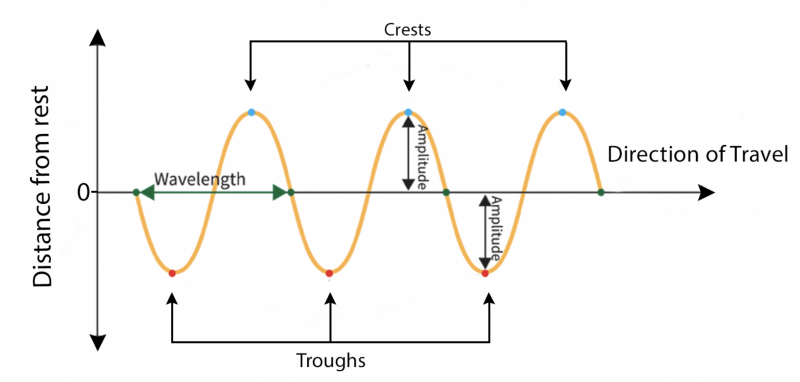Travelling Wave
Learning Objectives
-
Travelling waves
-
Wavelength, frequency, period and wave speed
-
Transverse and longitudinal waves
-
The nature of electromagnetic waves
-
The nature of sound waves
Application and Skills
- Explaining the motion of particles of a medium when a wave passes through it for both transverse and longitudinal cases
- Sketching and interpreting displacement–distance graphs and displacement– time graphs for transverse and longitudinal waves
- Solving problems involving wave speed, frequency and wavelength Investigating the speed of sound experimentally
Wave Introduction
A wave is a disturbance that travels in a medium, transferring energy and momentum from one place to another.
The direction of propagation of a wave is the direction of energy transfer. There is no large-scale motion of the medium itself as the wave passes through it.

- The length of a complete oscillation is known as the wavelength with a symbol of λ. The distance from crest to crest or trough to trough
- The time to create one complete oscillation is known as the period of the wave, with a symbol of T
-
The number of oscillations per second is called the frequency f of the wave. In general if the period is T then the frequency is the inverse



Waves are classified into two main categories: mechanical waves that requires a medium and electromagnetic waves that require no medium. Mechanical waves are consisted of transverse and longitudinal waves, and electromagnetic waves are light, microwaves, infrared, x-rays, ultraviolet, and radio waves based on the electromagnetic spectrum. The topic will be focusing on transverse, longitudinal, and electromagnetic waves.
Transverse Waves
A transverse wave is a wave whose oscillations are perpendicular to the direction of velocity/energy transfer. This contrasts with longitudinal wave which the velocity's direction is parallel the oscillations.
Some examples are
- ripples on the surface of water
- vibrations in a guitar string
- a Mexican wave in a sports stadium
- electromagnetic waves: microwaves, radio waves
- seismic S-waves
In a transverse wave the displacement is perpendicular to the direction of energy transfer.

https://tenor.com/view/longitudinal-wave-transverse-waves-waves-gif-13936583
Longitudinal Wave
Longitudinal waves are waves in which the direction of oscillation is parallel to the direction of velocity, meaning that the medium's displacement is in the same direction of the wave propagation.
- In a longitudinal wave the displacement is parallel to the direction of energy transfer.

Electromagnetic Waves
Electromagnetic waves or EM waves are waves that are created as a result of vibrations between an electric field and a magnetic field. In other words, EM waves are composed of oscillating magnetic and electric fields. This complicated definition will be introduced more detail in topic 5 of electricity and magnetism. Another simple definition is that electromagnetic spectrum is a spectrum comprised of all frequencies of electromagnetic radiation that propagate energy and travel through space in the form of waves. The family of EM waves consist of different wavelength, such as radio, microwave, infrared, visible, ultraviolet, X-Ray, and gamma ray, and each of their are used in different area with important roles.

According to the above equations, it can be seen that
- Higher frequency means shorter wavelength and larger energy carried by photon that made up electromagnetic radiations
- Lower frequency means longer wavelength and smaller energy carried by photon that made up electromagnetic radiations

The above image shows Maxwell's equations, one of the most remarkable inventions by physicians. Though content in this webpage is an introductory knowledge for waves and only touches surfaces of electricity and magnetism, it is highly encouraged to go beyond textbooks and explore.